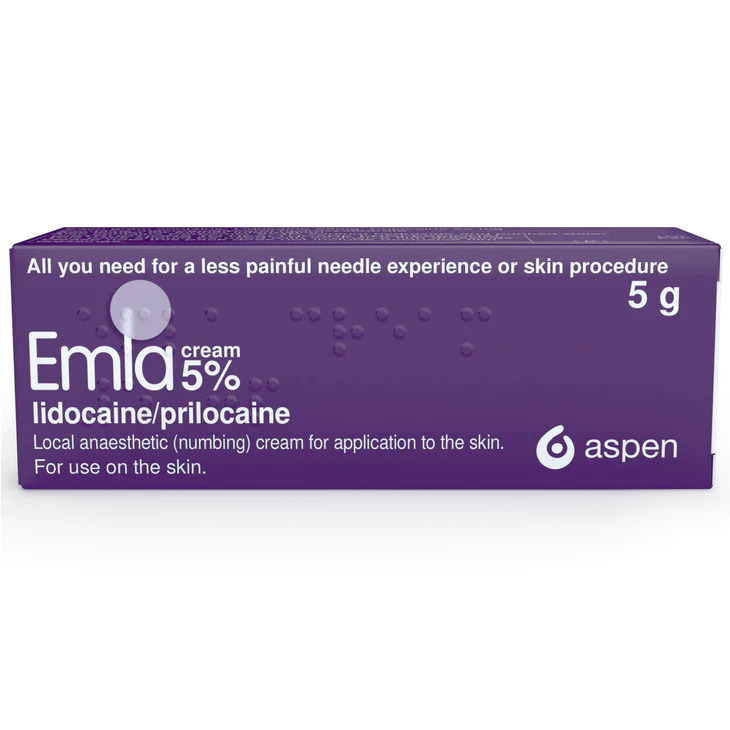Emla Cream 5%
£5.49 – £27.49
- Local Numbing Cream
- Active Ingredients: Lidocaine & Prilocaine
- Buy With Confidence From UK Registered Pharmacy
Emla cream contains two active substances, lidocaine and prilocaine, together they create a numbing effect. This numbing action works on the skin to provide pain relief during procedures that use a needle, such as blood tests and injections.
| Options | Price | Stock |
|---|---|---|
| With Dressings (5g) | £5.69 | In Stock |
| Without Dressings (5g) | £5.49 | In Stock |
| Without Dressings (30g) | £27.49 | In Stock |
| Pre-Medication Pack 5 x 5 g Cream with 12 Dressings | £25.49 | In Stock |

Discreet Packaging

UK Based
-
Buy Emla Cream 5% Online
My Pharmacy is the best place to Buy Emla Cream 5% Online. To Buy Emla Cream 5% Next Day Delivery you are not required to have a prescription, but you will need to complete our free online consultation service.Buy Emla Cream 5% UK Next Day Delivery
Through My Pharmacy you can Buy Emla Cream 5% Online. Each treatment is sent out in secure and discreet packaging ensuring that you get your medicine on time and intact.Emla Cream
Emla Cream UK contains two active substances called lidocaine and prilocaine. These belong to a group of medicines called local anaesthetics. Emla Cream works by numbing the surface of the skin for a short time. It is put on the skin before certain medical procedures. This helps to stop pain on the skin; however, you may still have the feelings of pressure and touch. In adults, adolescents and children, Emla Cream UK can be used to numb the skin before:- Have a needle put in (e.g., having an injection or a blood test)
- Minor skin operations
Emla Numbing Cream
One of the active ingredients in Emla Numbing Cream, lidocaine, is a local anaesthetic and makes the skin numb. Typically, this will be applied to the skin before having a small surgical procedure or when blood needs to be taken. Available in Emla Numbing Cream, lidocaine can also be found in different types of products, including mouth gels, throat sprays and suppositories.- Emla Numbing Cream works quickly – it takes 30 to 60 minutes to take effect.
- Only use the cream on undamaged skin, do not put it on cuts or grazes.
- Alongside Emla Numbing Cream, other brand names include LMX4 and Nulbia.
Emla Cream 5
Emla Cream 5 can also be used to numb the skin by adults and adolescents for:- Numbing the genitals before:
- Having an injection
- Medical procedures such as removal of warts
Emla Cream 30g
Do not use Emla Cream 30g:- If you are allergic to lidocaine or prilocaine, other similar local anaesthetics or any of the ingredients listed in the patient information leaflet.
- If you or your child have a rare inherited illness that affects the blood called ‘glucose-6-phosphate dehydrogenase deficiency’.
- If you or your child have a problem with blood pigment levels called ‘methaemoglobinaemia’.
- Do not use Emla Cream 30g on areas with skin rash, cuts, grazes or other open wounds, with the exception of a leg ulcer. If any of these problems are present, check with your doctor, pharmacist or nurse before using the cream.
- If you or your child have an itchy skin condition called ‘atopic dermatitis’, a short application time may be sufficient. Application times of longer than 30 minutes may result in an increased incidence of local skin reaction.
- If you take particular products for heart rhythm disorders. In that case the doctor will monitor your heart function.
Emla Cream Uses
Emla Cream 30g will usually be given to you on prescription ahead of your appointment/surgery. There are plenty of different Emla Cream uses relating to procedures and surgeries. Always follow the instructions given in the patient information leaflet.- If you’re having a drip fitted or having blood taken, put the cream on 1 hour beforehand.
- For minor surgery, a doctor may tell you to use cream more than 1 hour before the procedure.
- If the procedure is delayed and the numbing effects of the cream have worn off, ask a doctor or nurse for advice before using anymore cream.
- If the cream is being used for a cosmetic procedure, make sure to tell the person doing the procedure before it starts. It will help them know that the area has been numbed and you will not feel as much pain.
Emla Cream For Tattoos
Using Emla Cream for tattoos can numb the skin before laser tattoo removal. As a trusted numbing cream, Emla has been helping to reduce the pain of needle and laser procedures in the UK for more than 20 years. To apply Emla Cream for tattoos, do the following:- Select the right Emla pack depending on the size of your planned tattoo. Emla cream is available in two tube sizes: 5g and 30g.
- The 5g tube covers an area of skin about 4cm x 5cm, while the 30g tube covers an area of skin about 10cm x 12cm.
- You should not use more than 60g of Emla Cream for tattoos in one session. If in doubt, check where to apply Emla with your tattooist or practitioner.
- Emla cream needs adequate time to numb the skin, so make sure you leave yourself enough time to apply Emla ahead of your appointment. Emla usually takes about 1 hour to get to work, but it may be quicker on the face.
How Long Does Emla Cream Last?
A common question we often see online regarding this product is “How long does Emla Cream last?” Emla Cream needs to be applied about an hour in advance of the procedure to allow its numbing effect to work. If using Emla on your face, numbing may occur more quickly. After Emla Cream is removed, numbing usually lasts for at least 2 hours (this time may be shorter if using Emla on the face). Keep the amount of time Emla lasts in mind if you are planning a large/intricate tattoo or have a longer tattoo appointment. Have any other questions relating to “How long does Emla Cream last?” please contact our customer support team.Emla Cream Review
You can view any Emla Cream Review and reviews left by customers who have used our website and service via the product page. Customers can post a Emla Cream Review after purchase. To view more service reviews, click here to view our trustpilot page. Our team will also be able to advise on any alternative treatments should any Emla Cream Review cause you to look for an alternative.Emla Cream Boots
Whilst Emla Cream is available from other commercial stores like Emla Cream Boots, Emla Cream Tesco, Emla Cream Amazon, My Pharmacy offers a free online consultation as well as free shipping on orders over £40 with next delivery options also available. From My Pharmacy you can purchase your prescription treatments online without ever having to leave your home, making it much easier for people to get the vital treatments they need safely and promptly. Unlike Emla Cream Tesco, Emla Cream Amazon, Emla Cream Boots, My Pharmacy has an expert team of pharmacy professionals available to help via email, online chat and telephone should you have any questions regarding your current prescription or treatment. Our team will also be able to advise on any alternative treatments should the one you’re looking for not be available. See our thousands of 5 Star Ratings on Trustpilot from real customers. As an independent pharmacy, My Pharmacy is able to get the best prices for both generic and brand name treatments. When compared to other retailers such as Emla Cream Amazon, Emla Cream Boots, Emla Cream Tesco, My Pharmacy can be as much as 50% cheaper to buy the same products. -
Side Effects
Possible side effects
Like all medicines, this medicine can cause side effects, although not everybody gets them.
Contact your doctor or pharmacist if any of the following side effects bother you or do not seem to go away. Tell your doctor about anything else that makes you feel unwell while you are using EMLA Cream.
A mild reaction (paleness or redness of the skin, slight puffiness, initial burning or itching) may occur on the area on which EMLA is used. These are normal reactions to the cream and the anaesthetics and will disappear in a short while without any measures being needed.
If you experience any troublesome or unusual effects while you are using EMLA, stop using it and check with your doctor or pharmacist as soon as possible.Common (may affect up to 1 in 10 people)
• Transient local skin reactions (paleness, redness, swelling) in the treated area during treatment of skin, genital mucosa or leg ulcers.
• An initially mild sensation of burning, itching or warmth at the treated area during treatment of genital mucosa or leg ulcers.
Uncommon (may affect up to 1 in 100 people)
• An initially mild sensation of burning, itching or warmth at the treated area during treatment of the skin).
• Numbness (tingling) in the treated area during treatment of genital mucosa.
• Irritation of the treated skin during treatment of leg ulcers.
Rare (may affect up to 1 in 1,000 people)
• Allergic reactions, which in rare cases may develop into anaphylactic shock (skin rash, swelling, fever, respiratory difficulties and fainting) during treatment of skin, genital mucosa or leg ulcers.
• Methaemoglobinaemia (blood disorder) during treatment of the skin.
• Small dot-shaped bleeding on the treated area (particularly on children with eczema after longer application times) during treatment of the skin.
• Irritation of the eyes if EMLA Cream accidentally comes into contact with them during treatment
of the skin.Additional side effects in children
Methaemoglobinaemia, a blood disorder, which is more frequently observed, often in connection with overdose in newborn infants and infants aged 0 to 12 months. -
Further Information













